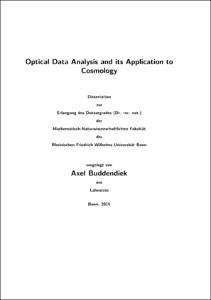Optical Data Analysis and its Application to Cosmology

Optical Data Analysis and its Application to Cosmology

| dc.contributor.advisor | Schneider, Peter | |
| dc.contributor.author | Buddendiek, Axel | |
| dc.date.accessioned | 2020-04-22T00:03:43Z | |
| dc.date.available | 2020-04-22T00:03:43Z | |
| dc.date.issued | 30.03.2016 | |
| dc.identifier.uri | https://hdl.handle.net/20.500.11811/6729 | |
| dc.description.abstract | This work is concerned with different aspects of observational cosmology. It covers a broad range of problems that one needs to deal with in optical astronomy. Three introduction chapters about cosmology, gravitational lensing, and galaxy clusters are followed by the three main chapters of the thesis. The first one is concerned with the problem of CCD crosstalk in OmegaCAM. OmegaCAM is a wide field imager at the VST in Chile, which suffers from interactions of some of its 32 CCD chips. These interactions appear to transfer flux between the chips after the exposures are finished. This is of course an unwanted effect that leads to errors in photometric measurements as well as in the object detection procedures. The development of a correction for this effect as well as its implementation for the Kilo Degree Survey are explained in detail. The second main chapter deals with massive high-redshift galaxy clusters. As it is possible to falsify the current cosmological standard model with just a single massive galaxy cluster searches for such objects have been conducted multiple times, especially at high redshifts. I introduce a new sample of 44 massive distant clusters, which were selected in the optical and X-ray. The results of the follow-up observing campaign in the optical and radio regimes are presented as well as a simple test of the cosmological standard model. As optical surveys of the large scale structure of our Universe become ever larger it is desirable to have several independent estimators of two-point correlations as well as procedures for data compression. A new way to combine galaxy clustering with galaxy-galaxy lensing in a compressed manner is described in the third main chapter. This new algorithm and its application to the Red Cluster Sequence Lensing Survey are presented in great detail. | en |
| dc.language.iso | eng | |
| dc.rights | In Copyright | |
| dc.rights.uri | http://rightsstatements.org/vocab/InC/1.0/ | |
| dc.subject | Kosmologie | |
| dc.subject | Astronomie | |
| dc.subject | Korrelationsfunktion | |
| dc.subject | Galaxienhaufen | |
| dc.subject | Gravitationslinseneffekt | |
| dc.subject.ddc | 520 Astronomie, Kartografie | |
| dc.subject.ddc | 530 Physik | |
| dc.title | Optical Data Analysis and its Application to Cosmology | |
| dc.type | Dissertation oder Habilitation | |
| dc.publisher.name | Universitäts- und Landesbibliothek Bonn | |
| dc.publisher.location | Bonn | |
| dc.rights.accessRights | openAccess | |
| dc.identifier.urn | https://nbn-resolving.org/urn:nbn:de:hbz:5n-43047 | |
| ulbbn.pubtype | Erstveröffentlichung | |
| ulbbnediss.affiliation.name | Rheinische Friedrich-Wilhelms-Universität Bonn | |
| ulbbnediss.affiliation.location | Bonn | |
| ulbbnediss.thesis.level | Dissertation | |
| ulbbnediss.dissID | 4304 | |
| ulbbnediss.date.accepted | 11.03.2016 | |
| ulbbnediss.institute | Mathematisch-Naturwissenschaftliche Fakultät : Fachgruppe Physik/Astronomie / Argelander-Institut für Astronomie (AIfA) | |
| ulbbnediss.fakultaet | Mathematisch-Naturwissenschaftliche Fakultät | |
| dc.contributor.coReferee | Reiprich, Thomas H. |
Files in this item
This item appears in the following Collection(s)
-
E-Dissertationen (4442)




